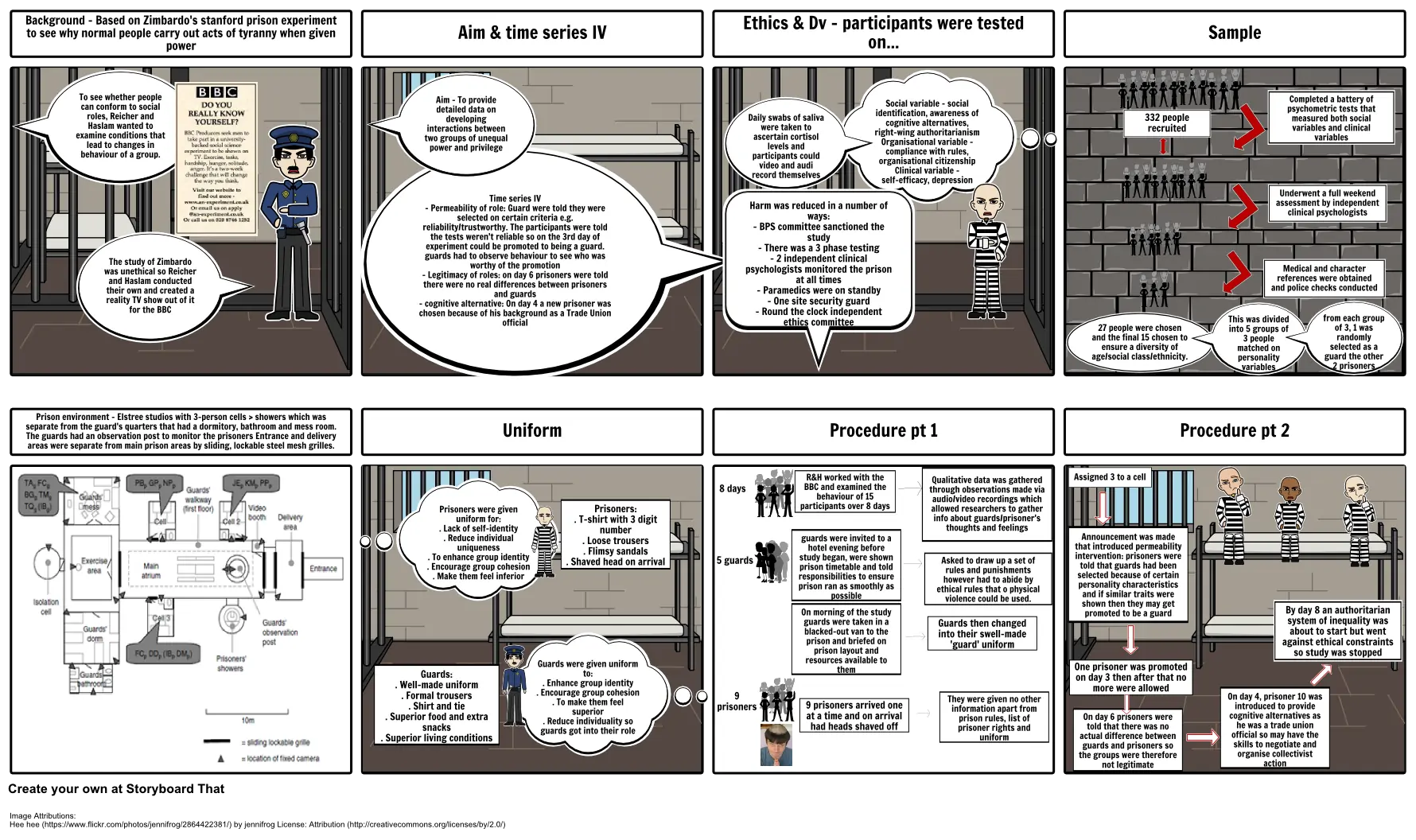Reicher and haslam revision resource

Storyboard Text
- Background - Based on Zimbardo's stanford prison experiment to see why normal people carry out acts of tyranny when given power
- The study of Zimbardo was unethical so Reicher and Haslam conducted their own and created a reality TV show out of it for the BBC
- To see whether people can conform to social roles, Reicher and Haslam wanted to examine conditions that lead to changes in behaviour of a group.
- Time series IV - Permeability of role: Guard were told they were selected on certain criteria e.g. reliability/trustworthy. The participants were told the tests weren't reliable so on the 3rd day of experiment could be promoted to being a guard. guards had to observe behaviour to see who was worthy of the promotion - Legitimacy of roles: on day 6 prisoners were told there were no real differences between prisoners and guards - cognitive alternative: On day 4 a new prisoner was chosen because of his background as a Trade Union official
- Aim & time series IV
- Aim - To provide detailed data on developing interactions between two groups of unequal power and privilege
- Ethics & Dv - participants were tested on...
- Harm was reduced in a number of ways: - BPS committee sanctioned the study - There was a 3 phase testing - 2 independent clinical psychologists monitored the prison at all times - Paramedics were on standby - One site security guard - Round the clock independent ethics committee
- Daily swabs of saliva were taken to ascertain cortisol levels and participants could video and audi record themselves
- Social variable - social identification, awareness of cognitive alternatives, right-wing authoritarianism Organisational variable - compliance with rules, organisational citizenship Clinical variable - self-efficacy, depression
- Sample
- 27 people were chosen and the final 15 chosen to ensure a diversity of age/social class/ethnicity.
- 332 people recruited
- This was divided into 5 groups of 3 people matched on personality variables
- Medical and character references were obtained and police checks conducted
- Completed a battery of psychometric tests that measured both social variables and clinical variables
- Underwent a full weekend assessment by independent clinical psychologists
- from each group of 3, 1 was randomly selected as a guard the other 2 prisoners
- Prison environment - Elstree studios with 3-person cells > showers which was separate from the guard's quarters that had a dormitory, bathroom and mess room. The guards had an observation post to monitor the prisoners Entrance and delivery areas were separate from main prison areas by sliding, lockable steel mesh grilles.
- Prisoners were given uniform for: . Lack of self-identity . Reduce individual uniqueness . To enhance group identity . Encourage group cohesion . Make them feel inferior
- Uniform
- Guards were given uniform to: . Enhance group identity . Encourage group cohesion . To make them feel superior . Reduce individuality so guards got into their role
- Prisoners: . T-shirt with 3 digit number . Loose trousers . Flimsy sandals . Shaved head on arrival
- 8 days
- 5 guards
- Procedure pt 1
- guards were invited to a hotel evening before study began, were shown prison timetable and told responsibilities to ensure prison ran as smoothly as possible
- On morning of the study guards were taken in a blacked-out van to the prison and briefed on prison layout and resources available to them
- R&H worked with the BBC and examined the behaviour of 15 participants over 8 days
- Qualitative data was gathered through observations made via audio/video recordings which allowed researchers to gather info about guards/prisoner's thoughts and feelings
- Asked to draw up a set of rules and punishments however had to abide by ethical rules that o physical violence could be used.
- Guards then changed into their swell-made 'guard' uniform
- Procedure pt 2
- Assigned 3 to a cell
- Announcement was made that introduced permeability intervention: prisoners were told that guards had been selected because of certain personality characteristics and if similar traits were shown then they may get promoted to be a guard
- By day 8 an authoritarian system of inequality was about to start but went against ethical constraints so study was stopped
- Guards: . Well-made uniform . Formal trousers . Shirt and tie . Superior food and extra snacks . Superior living conditions
- 9 prisoners
- 9 prisoners arrived one at a time and on arrival had heads shaved off
- They were given no other information apart from prison rules, list of prisoner rights and uniform
- One prisoner was promoted on day 3 then after that no more were allowed
- On day 6 prisoners were told that there was no actual difference between guards and prisoners so the groups were therefore not legitimate
- On day 4, prisoner 10 was introduced to provide cognitive alternatives as he was a trade union official so may have the skills to negotiate and organise collectivist action
Image Attributions
- Hee hee - jennifrog - (License Attribution )
Over 30 Million Storyboards Created

